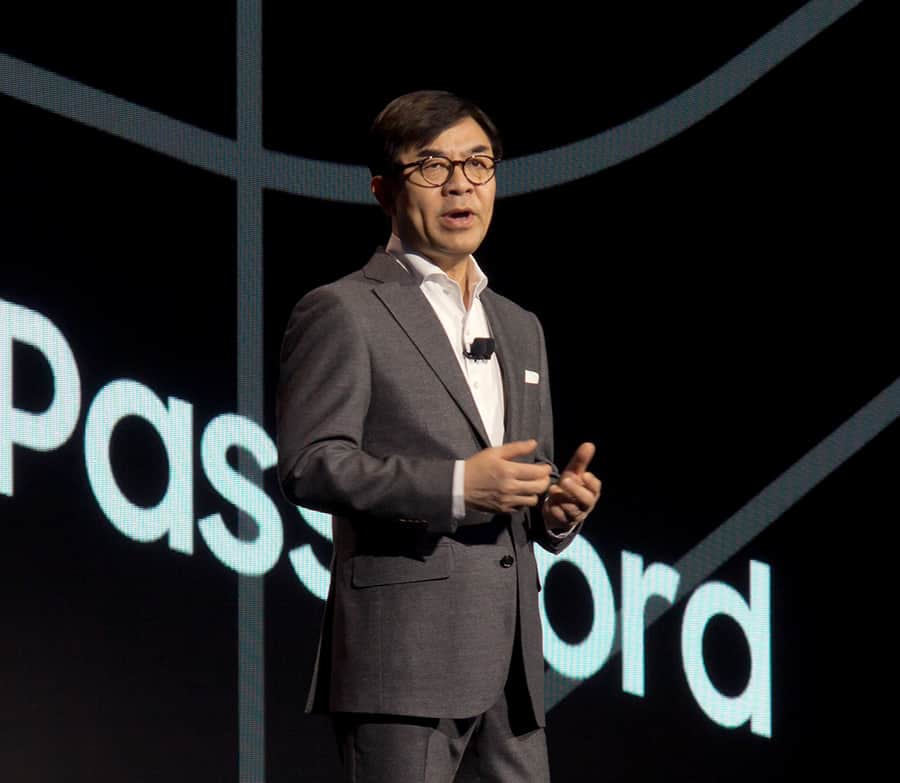
President Hyunsuk Kim, Head of Samsung’s Consumer Electronics Division, speaking at the company’s press conference at CES. Photograph by Mark Lyndersay. Click smaller images to enlarge.
BitDepth#1127 for January 11, 2018
Samsung led big with its presentation at CES 2018, introducing the intimidatingly named The Wall, a massive 146 inch television sporting a list of new technologies.
Key among these are newly developed MicroLED imaging sites that supply their own light and dispense with the backlighting and colour filter normally used on LED displays. The company claims dramatically improved colour and brightness with the new technology (video here).
But at a press conference held on Monday at the Mandalay Bay hotel in Las Vegas, the message, tightly woven into the introduction of new refrigerators, a new laptop designed with Note lovers at heart and a revamped line of televisions and screens, was all about the creation of a network for the future.
A surprising amount of what the company revealed at the event was still in various stages of development.
The company has been buying startups by the dozens, and has invested $14 billion in R&D. A new, $380m US based production facility will deliver its first washing machines next week.
All told, Samsung sells a billion devices a year and has quietly made a startling 90 percent of them networkable. The company plans to only have connectable devices coming off its manufacturing lines by 2020.
The company has a clear understanding of what happens when open protocols and software are allowed to proliferate and is working closely with the other 296 members of the Open Connectivity Foundation to limit IOT protocol fragmentation.
But making its devices talk to each other is only the first step in what is clearly an ambitious plan to carve out a new presence for the Samsung brand in a rapidly evolving technology landscape.
Kim announced that previous technologies designed to link its devices into useful networks, Samsung Connect, Smart Home and Smart View would be deprecated and replaced with a new SmartThings app, available in the third quarter of 2018.
SmartThings is an Internet of Things platform developer that Samsung acquired in 2014 and the company’s cloud platform, hub technology and software have assumed great prominence in the future plans of Samsung as an enabler of seamless lifestyle connectivity.
SmartThings already connects to 400 existing devices, explained Tim Baxter, President and CEO of Samsung Electronics America.
“IOT has to be open, so that it can be easily connected, it has to be seamless for the consumer, and it must be intelligent, so that they [the users] can do more,” said Kim.
Bixby, the AI built into all recent Samsung mobile phones is now going to be in all its connected devices, a learning agent constantly monitoring lifestyle choices and being able to offer suggestions or take actions as users request them.
This new emphasis on devices linked for mutual advantage was underlined at every point in every discussion of the new products, sending a clear signal that the effective implementation of user-friendly network, not the products was the medium term goal of the company.
It was particularly focused in the presentation by Dinesh Paliwal, President and CEO of Harman, a company once in the business of audio for the home and the automobile, but acquired in November 2016 by Samsung and refocused on the many challenges of self-driving vehicles.
The company announced three products in its initial beachhead on this evolving landscape, a Telematics control unit governing a sensor network for these vehicles, Driveline, a merging of high performance computing and pervasive cloud presence and most appealing, a reimagining of the car dashboard as an all digital cockpit, showing both sleek modern touches and retro styling that was a joy to view.
The vehicle technology and to a lesser extent its lifestyle network enabled by AI agents and pervasive sensors will work with 4GLTE but is being designed with an eye on 5G networks, which will enable fiber-level bandwidth in the hundreds of gigabits.
Samsung isn’t waiting on that day though.
The company has tested 5G at two locations in Korea and proven that it can stream 8K video to a train traveling at 60 mph.
Rejuvenated by their year of quiet reflection in the wake of the Note 7 disaster, Samsung is now a company that wants to slap all these balls for six and it’s aiming well beyond the expectations.
The company is preparing itself to occupy a market position that is both technologically and strategically competitive with its considerable competition across a range of devices and lifestyle networks.
The multidevice connectivity strategy is a bold gamble, but it’s one that positions the company to be a very different presence in the technology landscape in years to come.




